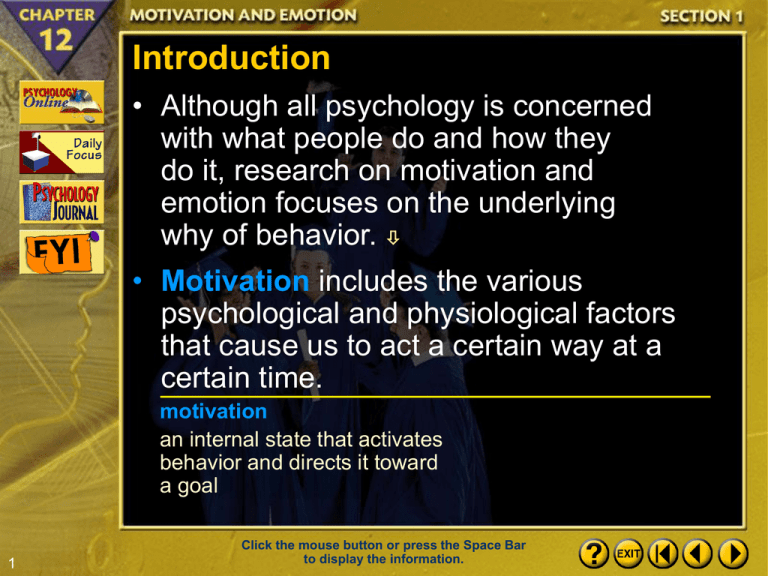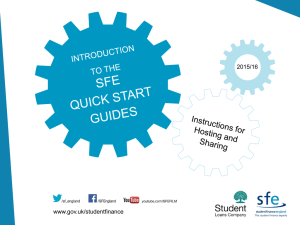File
advertisement

Introduction • Although all psychology is concerned with what people do and how they do it, research on motivation and emotion focuses on the underlying why of behavior. • Motivation includes the various psychological and physiological factors that cause us to act a certain way at a certain time. motivation an internal state that activates behavior and directs it toward a goal 1 Click the mouse button or press the Space Bar to display the information. Instinct Theory • In the 1900s, psychologist William McDougall (1908) proposed that humans were motivated by a variety of instincts. • Instincts are natural or inherited tendencies of an organism to make a specific response to certain environmental stimuli without involving reason. instincts innate tendencies that determine behavior 2 Click the mouse button or press the Space Bar to display the information. Drive-Reduction Theory • Something that motivates us moves us to action. • That “something” that motivates us starts with a need and leads to a drive. • A need results from a lack of something desirable or useful. • We have both physiological and psychological needs. need biological or psychological requirement of an organism 3 Click the mouse button or press the Space Bar to display the information. Drive-Reduction Theory (cont.) • A need produces a drive. • A drive is an internal condition that can change over time and orients an individual toward a specific goal or goals. • We have different drives with different goals. drive a state of tension produced by a need that motivates an organism toward a goal 4 Drive-Reduction Theory (cont.) • Drive-reduction theory emerged from experimental psychologist Clark Hull, who traced motivation back to basic physiological needs. • Thus, biological needs drive an organism to act. • Homeostasis is the tendency of the body to return to or maintain a balanced state. homeostasis the tendency of all organisms to correct imbalances and deviations from their normal state 5 Click the mouse button or press the Space Bar to display the information. Drive-Reduction Theory (cont.) • If a behavior reduces the drive, the organism will begin to acquire a habit. • In short, drive-reduction theory states that physiological needs drive an organism to act in either random or habitual ways until its needs are satisfied (until the organism returns to a preset optimal state). • Hull suggested that all human motives– from the desire to acquire property to striving for excellence and seeking affection or amusement–are extensions of basic biological needs. 6 Click the mouse button or press the Space Bar to display the information. Incentive Theory • The drive-reduction theory of motivation emphasizes the internal states of the organism; however, the incentive theory stresses the role of the environment in motivating behavior. • An incentive is the object we seek or the result we are trying to achieve through our motivated behavior. incentive an external stimulus, reinforcer, or reward that motivates behavior 7 Click the mouse button or press the Space Bar to display the information. Cognitive Theory • Cognitive psychologists seek to explain motivation by looking at forces inside and outside of us that energize us to move. • They propose that we act in particular ways at particular times as a result of extrinsic and intrinsic motivations. 8 Click the mouse button or press the Space Bar to display the information. Cognitive Theory (cont.) • Extrinsic motivation refers to engaging in activities to reduce biological needs or obtain incentives or external rewards. • Intrinsic motivation refers to engaging in activities because those activities are personally rewarding or because engaging in them fulfills our beliefs or expectations. extrinsic motivation engaging in activities that either reduce biological needs or help us obtain external incentives 9 intrinsic motivation engaging in activities because they are personally rewarding or because they fulfill our beliefs and expectations Click the mouse button or press the Space Bar to display the information. Cognitive Theory (cont.) • In many instances, you engage in an activity because of both extrinsic and intrinsic motivations. • If you are motivated by both intrinsic and extrinsic motivations, do you perform more effectively or persistently at a task? • Psychologists have proposed the overjustification effect–when people are given more extrinsic motivation than necessary to perform a task, their intrinsic motivation declines. 10 Click the mouse button or press the Space Bar to display the information. Reader’s Guide (cont.) Vocabulary – lateral hypothalamus (LH) – ventromedial hypothalamus (VMH) – fundamental needs – psychological needs – self-actualization needs Click the Speaker button to listen to Exploring Psychology. 11 Click the mouse button or press the Space Bar to display the information. Section 2 begins on page 319 of your textbook. Biological Motives • Some behavior is determined by the internal, or physiological, state of the organism. • All organisms, including humans, have built-in regulating systems that work like thermostats to maintain such internal processes as body temperature, the level of sugar in the blood, and the production of hormones. • The tendency of all organisms to correct imbalances and deviations from their normal state is known as homeostasis. 12 Click the mouse button or press the Space Bar to display the information. Some Biological and Social Needs 13 Hunger • Your body requires food to grow, to repair itself, and to store reserves. • To what is it responding? • If the portion of the hypothalamus called the lateral hypothalamus (LH) is stimulated with electrodes, a laboratory animal will begin eating, even if it has just finished a large meal. lateral hypothalamus (LH) the part of the hypothalamus that produces hunger signals 14 Click the mouse button or press the Space Bar to display the information. Hunger (cont.) • If the ventromedial hypothalamus (VMH) is stimulated, an animal will slow down or stop eating altogether, even if it has been kept from food for a long period. • This indicates that the VMH provides the “stop” signals: it tells you when you have had enough food. ventromedial hypothalamus (VMH) the part of the hypothalamus that can cause one to stop eating 15 Click the mouse button or press the Space Bar to display the information. Hunger (cont.) • Other factors also influence your hunger. • The glucostatic theory suggests that the hypothalamus monitors the amount of glucose, or ready energy, available in the blood. • Another factor affecting eating is the setpoint–the weight around which your day-today weight tends to fluctuate. • The hypothalamus “interprets” at least three kinds of information: the amount of glucose entering the cells of your body, your set-point, and your body temperature. 16 Click the mouse button or press the Space Bar to display the information. Hunger (cont.) Hunger–Other Factors • Besides the biological motives, other factors may be at work when you feel hungry or eat. • Psychosocial factors have a huge impact on our eating habits and sometimes contribute to eating disorders, such as binge eating, eating when depressed, or not eating enough. 17 Click the mouse button or press the Space Bar to display the information. Obesity • There is a growing body of evidence that a person’s weight is controlled by biological factors. • Stanley Schachter (1971) and his colleagues at Columbia University conducted studies that show that obese people respond to external cues. • Obese people eat not because they are hungry, but because they see something good to eat or their watches tell them it is time to eat. 18 Click the mouse button or press the Space Bar to display the information. Obesity (cont.) • Schachter argued that overweight people respond to external cues, while normalweight people respond to internal cues. • His work shows that, for people, even physiological needs like hunger are influenced by complex factors. 19 Click the mouse button or press the Space Bar to display the information. Percentage of Overweight Americans 20 Social Motives • Many psychologists have concentrated their research on social motives rather than on the unlearned, biological motives we have been discussing. • Social motives are learned from our interactions with other people. 21 Click the mouse button or press the Space Bar to display the information. Measuring the Need for Achievement • The achievement motive concerns the desire to set challenging goals and to persist in trying to reach those goals despite obstacles, frustrations, and setbacks. • Researcher David McClelland’s main tool for measuring achievement motivation was the Thematic Apperception Test (TAT). • Critics have claimed that using McClelland’s TAT is not a reliable method of testing the need for achievement. 22 Click the mouse button or press the Space Bar to display the information. Measuring the Need for Achievement (cont.) Fear of Failure • While some people are motivated by a need for achievement, others may be motivated by a fear of failure. • How does the fear of failure differ from the need for achievement? • People display fear of failure when they choose easy or nonchallenging tasks in which failure is unlikely or difficult. 23 Click the mouse button or press the Space Bar to display the information. Measuring the Need for Achievement (cont.) Fear of Success • Matina Horner identified another dimension of achievement motivation–the motive to avoid success. • Horner discovered that bright women, who had a very real chance of achieving in their chosen fields, exhibited a stronger fear of success than did women who were average or slightly above average. • Fear of success is found in both men and women. 24 Click the mouse button or press the Space Bar to display the information. Your Performance 25 Measuring the Need for Achievement (cont.) Other Theories • J.W. Atkinson developed an expectancyvalue theory to explain goal-directed behavior. • Expectancy is your estimated likelihood of success, and value is simply what the goal is worth to you. • Others have argued instead for a competency theory; too easy a task or too difficult a task means we do not learn anything about how competent we are. 26 Click the mouse button or press the Space Bar to display the information. Maslow’s Hierarchy of Needs • Abraham Maslow believed that all human beings need to feel competent, to win approval and recognition, and to sense that they have achieved something. • He placed achievement motivation in the context of a hierarchy of needs all people share. • Maslow’s scheme incorporates all the factors we have discussed so far in this chapter and goes a step further. 27 Click the mouse button or press the Space Bar to display the information. Maslow’s Hierarchy of Needs (cont.) 28 Maslow’s Hierarchy of Needs (cont.) • Maslow asserted that people have to satisfy fundamental needs to live. • The second level in Maslow’s hierarchy consists of psychological needs: the need to belong and to give and receive love, and the need to acquire esteem through competence and achievement. fundamental needs biological drives that must be satisfied to maintain life 29 psychological needs the urge to belong and to give and receive love, and the urge to acquire esteem Click the mouse button or press the Space Bar to display the information. Maslow’s Hierarchy of Needs (cont.) • Self-actualization needs are at the top of Maslow’s hierarchy. • These may include the pursuit of knowledge and beauty or whatever else is required for the realization of one’s unique potential. self-actualization needs the pursuit of knowledge and beauty or whatever else is required for the realization of one’s unique potential 30 Click the mouse button or press the Space Bar to display the information. Maslow’s Hierarchy of Needs (cont.) • Other research does not support Maslow’s conclusion that one need must be satisfied before another can be (Liebert & Spiegler, 1994). • Also, some people do not seem interested in fulfilling higher needs. • These researchers are suggesting that perhaps Maslow identified types of needs that may operate in all of us, but there is no guarantee that the needs must be satisfied in order. 31 Click the mouse button or press the Space Bar to display the information.




